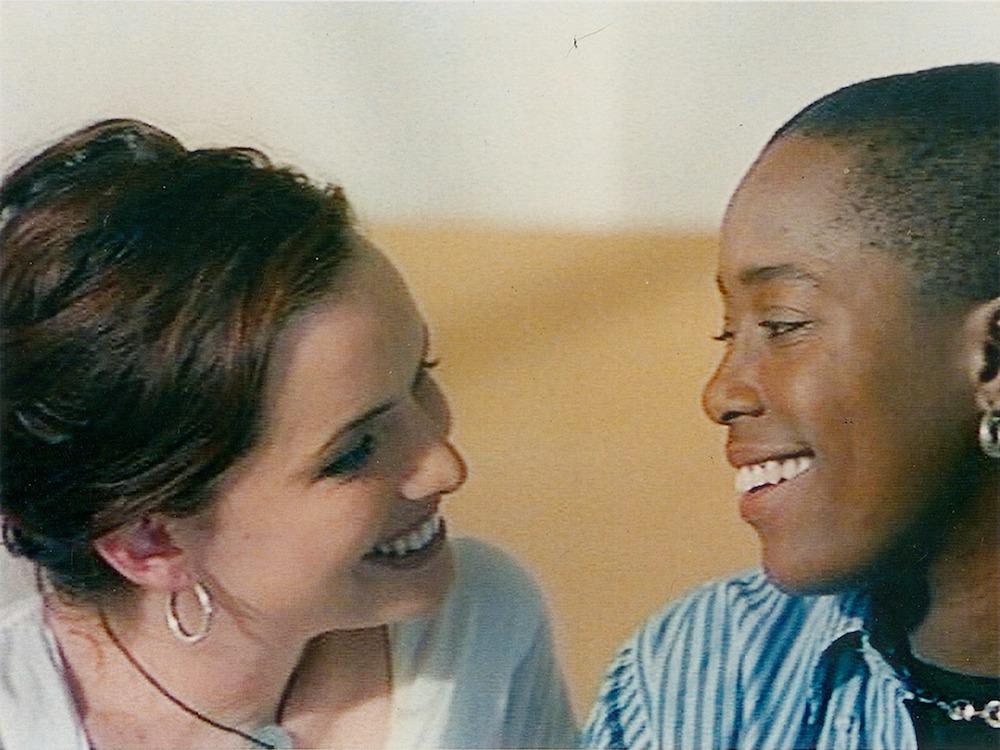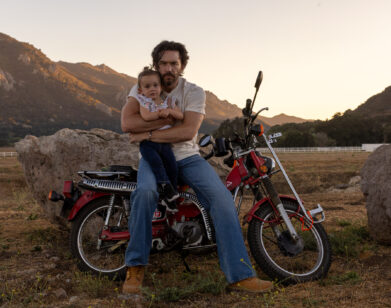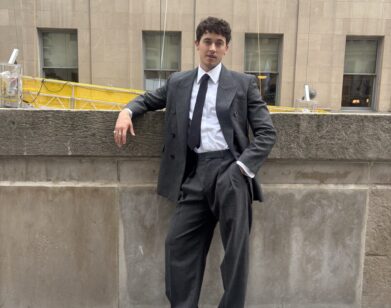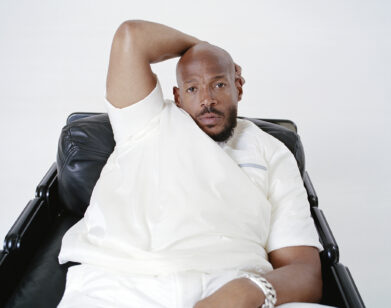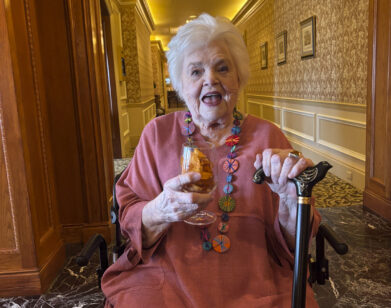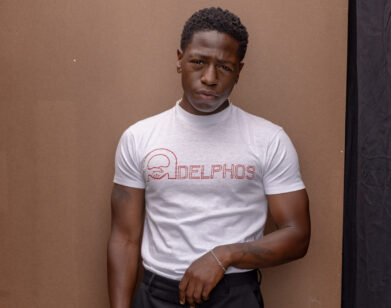Cheryl Dunye’s Alternative Histories
Cheryl Dunye’s 1996 debut, The Watermelon Woman, defies all categorization. A hybrid of autobiography, documentary, comedy, and meta-narrative, it was a landmark of New Queer Cinema and the first feature film directed by an African American lesbian. With biting humor and a sharp eye towards hidden histories, the film deftly captures the search for identity and how we, in turn, preserve and share history, from the stories told by our selves, families, and communities, to those produced by Hollywood and culture writ large.
Dunye casts herself as Cheryl, a twentysomething aspiring filmmaker living in Philadelphia, who picks up gigs doing shifts at a local video store and as a wedding videographer to make cash to fund her passion project—a documentary that tracks her search for the biography of a glamorous African American actress, Fae Richards, who appeared largely in Civil War films from the ’30s and ’40s in stereotypical mammy roles and was elusively credited only as “The Watermelon Woman.” As Cheryl digs deeper into the life of Richards, unearthing archival material and interviewing experts and acquaintances, she makes discoveries that resonate with her own life: Richards, too, lived in Philadelphia and was queer, and had an affair with her white female director; Cheryl learns about this as she embarks on a new interracial relationship with Diana, a patron at the video store.
The catch, revealed at the end of the film, is that Richards’s biography is invention. Dunye collaborated with photographer Zoe Leonard to create archival footage and photographs that mimicked authenticity; Richards’s invented story came out of Dunye’s own fruitless search for a black queer actress like her in Hollywood history.
Starting today, The Watermelon Woman will begin a weeklong run at the Metrograph theater in New York on the occasion of its twentieth anniversary. Interview spoke to Dunye by phone.
COLLEEN KELSEY: I’m curious about what your relationship is with the film now, considering where you were as a filmmaker, what your creative goals were at the time. What is it like to see this piece of work from your perspective now?
CHERYL DUNYE: Looking at The Watermelon Woman with my fresh eyes as a filmmaker, of course I look at all the moments with a nostalgic lens. My mother is in this film, many of my friendships and relationships are portrayed, or helped make the film. It was really made collectively. It started with my partner at the time, who was the producer, and actually is the mother of my kid and a wonderful academic: Alexandra Juhasz. We were the driving force behind it, so I can even now start to look at that concept that filmmaking has for writer-directors with auteur-y type of work, where no matter what the film you’re making, some aspect of it comes from your relationship and the dynamics of it. So I look at how the relationship between Diana and Cheryl, the character, was playing off a little bit of the relationship between Alex and Cheryl. But it wasn’t articulated then. I don’t think I had words for it and I think the work became a way to express that.
KELSEY: Recreation of history is the major crux of the film, which is revealed to be fiction at the end of the film. Many viewers take it at face value as truth, until the end, of course. How did you arrive at that conceit?
DUNYE: When I started to look at purchasing archives to use technically in the film, they were out of our budget and out of our range—we had no money at that time. That pushed me closer to collaborating with my friend, the photographer Zoe Leonard, and bringing together a troupe of people to reinvigorate and put a lens on this project within the queer community as something that’s happening. It really did this twofold thing and allowed me to create, in the pre-Kickstarter days, an object to auction off later. We put the pictures up and people came and got to buy a print to help support the film for fifty bucks. It was something really inexpensive, and now those pictures are worth thousands in permanent collections, so it’s quite interesting that way.
I wanted to pop out from what was going on in “Indiewood” at the time, especially New Queer Cinema—everybody was still scrambling to make their identity piece. I think for me as a lesbian, Go Fish [1994] was right in front of me. I grabbed Gwen [Guinevere Turner, who plays Diana in the film] from it to build on that audience. I wanted to do something different, actually do storytelling. I love the work of Todd Haynes. I love the work of Tom Kalin, Tom and I are really good friends. Seeing Swoon [1992] and seeing how he put his personal and political into entertaining and was able to do that on both sides of the lens, I wanted to do something like that. Really integrating the pictures and that concept was key. I got my MFA in art school, Rutgers, Mason Gross School of the Arts. Martha Rosler was like, “Do something.” I was really kicked to do something. I just took a leap, which wasn’t heard of at that point.
KELSEY: I wanted to talk a bit about crafting the alter ego of yourself as the protagonist—what were the gaps between who you were as the filmmaker versus how you created that version of Cheryl?
DUNYE: I think creating a character that had cinematic aspirations that weren’t my own—mine were definitely as a writer/director, but what would be another space that somebody could want to have a relationship or a future in cinema? I really looked for these careers, and it was the heyday of video stores, you know? That was a place of learning and community. It was ideal to craft that world there for Cheryl. It all just stems from that. I was able to then lay a lot of the authentic search right on that timeline. I did look for a black lesbian in Hollywood with this story. I did do that as my research for the film, for a year. What I found was nothing. So, I had to tell that truth. I think that’s where the film gets its real depth. You can see this protagonist doing this whole thing. The plot and the story end, but this is a truth. So I had to play Cheryl. I had to do that. My prior work, my shorter work, I played “Cheryl,” or other names. It was about the talking head, which I called the “Dunyementary.” That was my thesis statement for my MFA. I really built on that. Most of my work does break into that with the talking head. A few Hollywood things that I did don’t have that. Stranger Inside [2000], the one I did with HBO, and of course, My Baby’s Daddy [2004] that I did with Miramax, really don’t explore that sort of interruption, and playing with form, but The Watermelon Women was the big piece that was putting it all together.
KELSEY: Well, my next question was about this combination of narrative, comedy, documentary, and autobiography, which you just spoke about. What are some of your formative influences?
DUNYE: With comedy: you’re always looking for yourself in something, right? That’s our drive to do that. So with comedy I was looking for the history of black queer representation. In the video store, and my archiving video stores, and being an active person, because sometimes they had some weird VHS tapes, I did come across this film called Norman…Is That You? [1976]. Pearl Bailey and Redd Foxx are these parents of a son that they visit in L.A. who has been closeted and is gay and lives in this sort of early ’70s, weird apartment, over the top, hiding the boyfriend in the closet. That was a hoot. It was really a hoot! It was also that time that I discovered the film The Watermelon Man [1970], which is another way to talk about race, by a wonderful director, Melvin Van Peebles, who I love, and I looked at all his stuff.
Queer politics at this point, in the early ’90s, was really driven by activism. I think ACT UP and our lives and how we organized was really talking about that. My friend Essex Hemphill, my forefather Marlon Riggs, who was doing this more on the documentary side, were already doing this stuff in their work, and I had met them and touched them, and they said, “Just go do it. You did these shorts. Just go do it Cheryl.” So, really, even looking at Marlon and working around Marlon and praising him until his death, I was able to say, “Form is important.” Playing with form, we have to also change not only the stories that are being told and filling the void, but we also have to really push how narrativity works, how stories are told. This is what I find interesting that has not really been done so much. Everybody is turning back the hands of time; Passion of Christ 2 is coming out. Like, what? We’re not pushing narrativity in telling a story, we’re retelling the past with the same properties and qualities of narrative: the happy ending, the sad ending. Really The Watermelon Woman was, and I still do this in my work, trying to not only entertain and engage, but also trying to invent, and I think that’s what I just really like to do, as an artist and as a filmmaker.
KELSEY: The ’90s was such a fertile time for a lot of artwork, but it was also a time where great artists were being scrutinized because of the conservative backlash against National Endowment for the Arts funding, and I know you went through that personally with The Watermelon Woman. [Dunye was given a $31,000 grant by the NEA for the film only to have her work singled out by Representive Peter Hoekstra for its lesbian sex scene]. What was that experience like for you?
DUNYE: It was a slap in the face in a weird way. It was a gift, it was a slap in the face, it was something that was stimulating to me, like, “Wow I did the right thing as an artist.” The story behind Hoekstra on the Congressional floor, with Sheila Jackson Lee; I’m glad Sheila Jackson Lee stood up for me, thank goodness for Sheila Jackson Lee. But it goes onto a further debate, where it’s people like Hollywood stars, Alec Baldwin was the one representing the NEA and my project. But nobody contacted me. I don’t think that would happen at this point, I think CNN or Fox would have just put the person on. But at that point in that debate, I was sort of like “The Watermelon Woman,” you know? Talked about, but I didn’t have a real face. I was just a puppet within that thing, and I just think that that for me is that double-edged sword about making work. It’s out there, people can do whatever they want with it. That, I walked away with thinking, “Wow, here was a transcendent moment, and I have no answers. I just have more work to make.” So, that’s the way the lens gets changed. [laughs]
KELSEY: So, tell me about what’s next. I know [Dunye’s short film] Black is Blue was playing festivals.
DUNYE: Christina Anderson, a wonderful playwright, an African American lesbian playwright in New York and I, took and developed the story from just a story about Black, to a story about Blue as a black trans woman involved in the tech world here. I don’t know if you know who Martine Rothblatt is, and the whole BINA48 thing, but when I got turned on to that I was trying to figure out how to incorporate that, so, I’m making a feature now, shooting in the spring. Marc Smolowitz is producing and Kingston [Farady, who plays Black in Black is Blue, the short] is going to be in it, and we are looking for our Blue. It’s a very powerful trans love story set in Oakland here in the world of tech, a little bit in the future, and what sort of the pressures of the city and the pressures of this relationship have to how this couple fall in love and fall out of love.
It’s a film noir, I would say that, but one of the characters is a bot, so we are now developing an AI friend bot companion for Blue, the trans woman that Black gets taken in by. What I’m doing, when [Black is Blue] ends with Black walking into the night, I pick up and tell the rest of the story, but doing what I did with The Watermelon Woman. This is staying in Oakland. This is bringing people in Oakland into the film where I’m using the community that same way. It’s a great cornerstone piece. Bill Coleman, who did the music [for The Watermelon Woman], I’m talking with him about thinking about doing the sound and music for the film. I really also believe that it’s a community of making, so I’m really trying to put Oakland on the map. People are really looking at this city, and there’s a lot of support for filmmakers.
FOR MORE ON CHERYL DUNYE, VISIT HER WEBSITE.

